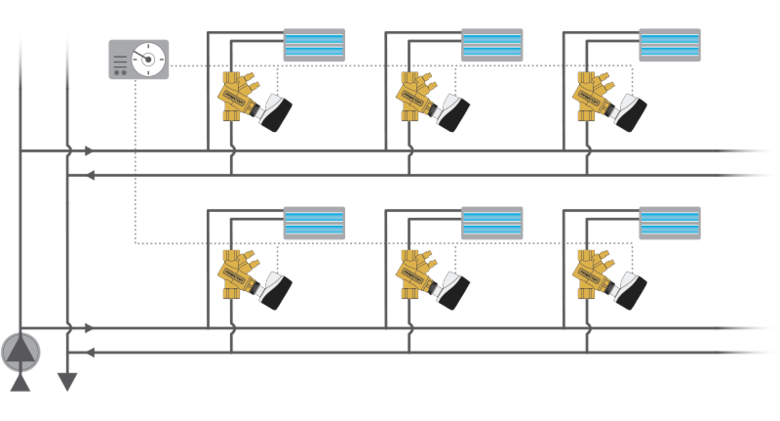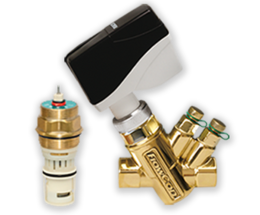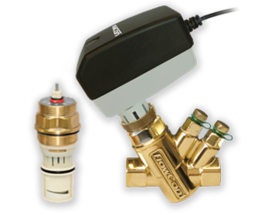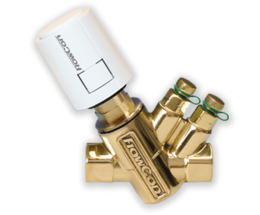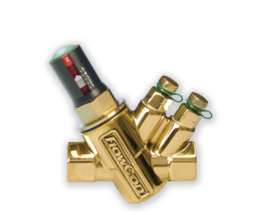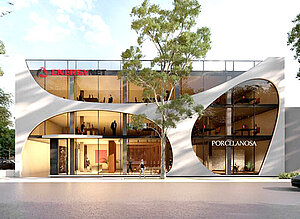Chilled Ceilings
What is a Chilled Ceiling system?
A chilled ceiling is a type of convection system designed to cool workspaces and the like. Often, they are integrated into the suspended ceiling system. A chilled ceiling is piped to allow chilled water circulation through the ceiling to thermally affect the room air. As the air becomes denser and falls to the floor. It is replaced by warmer air moving up from, causing a constant passive air movement called convection, which cools the room. But as the pipes lie behind metal ceiling plates it is actually the cooled plates that are the cause of convection and not the pipe unit itself. Therefore, chilled ceilings are less effective in comparison with chilled beams.
Chilled ceilings are commonly seen in office areas, wards and other similar facilities and both pipe size and flow rates are normally in the lower end.
How is a Chilled Ceiling Application Optimized?
A chilled ceiling will - with proper balance on the water - reduce flow to design requirements and save energy. FlowCon recommends three different solutions to a chilled ceiling installation:
1. Chilled Ceilings with Pressure Independent Control (PICV)
The PICV will react to system pressure changes and regulate the flow of water to required flow by adjusting the actuator position. This helps the system to be accurately controlled even with pressure changes and reduced loads.
→ Download Application Drawing Example
FlowCon recommends the following PICVs:
2. Chilled Ceilings with Temperature Control (TCV)
The TCV will react to system pressure changes and automatically provide the selected max. flow independent of pressure changes. In addition, the actuator will provide ON/OFF control, securing proper thermal performance always, even at partial loads.
→ Download Application Drawing Example
FlowCon recommends the following TCV:
3. Chilled Ceilings with Automatic Balancing (ABV)
The automatic balancing valve will react to system pressure changes and limit the flow of hot or cold water to required max. flow helping the system to be accurately controlled even with pressure changes. This solution may be installed with the separate control valve.
→ Download Application Drawing Example
FlowCon recommends the following ABVs:
Some FlowCon Projects with Chilled Ceilings
See all projects
Energy Net, Novi Sad, Serbia
Energy Net’s new Headquater, Serbia. Balanced and controlled with FlowCon PICVs
COVID-19 Hospital on Batajnički Drum in Belgrade, Serbia
Brand new COVID-19 hospital in the Serbian Capital – FlowCon is proud to contribute
Epidemic Hospital at Rasina Military Complex, Kruševac, Serbia
New COVID-19 hospital in Serbia – proud to contribute
Mercedes-Benz HQ in Nieuwegein, The Netherlands
Circular Building - going from old and empty to modern and sustainable
New South Glasgow Hospital, Glasgow, Scotland
FlowCon PICVs secure optimal comfort for staff, patients and visitors in Europe’s largest hospital

Still in Doubt?
Please Contact Us
If You are in doubt which Solution to choose to Your Application or how a specific product is working, please do not hesitate contacting FlowCon.
We will react as soon as possible, and written reply is normally within 8 hours if Your question is asked in English and during office hours. Other languages and requests asked during vacation time or weekends may experience longer response time. Likewise, for any special and out of standard requests, You may not see an immediate reply, but we are responsive.
